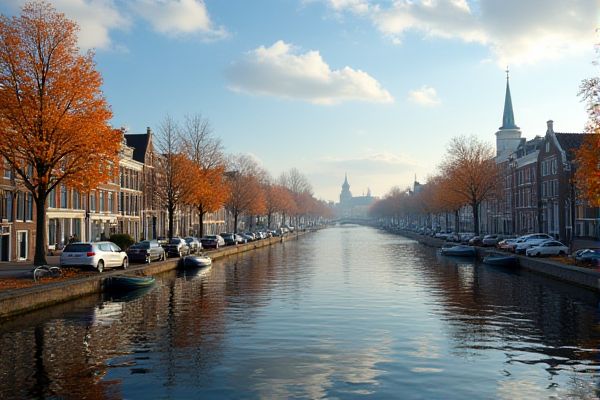
Weather and climate in Netherlands: Mild maritime climate. Frequent rainfall. High humidity. Mild winters. Cool summers. Windy conditions. Coastal influence. Occasional snow. Changing weather patterns. Use of rain gear.
Mild maritime climate
The Netherlands experiences a mild maritime climate, with summers that are generally mild and winters that tend to be cold. This climate is shaped by its proximity to the North Sea and the Atlantic Ocean, which moderate temperatures throughout the year. Wind and rain are common occurrences, contributing to the distinct weather patterns in the country. For more detailed information, you can explore the Weather Climate Netherlands, which provides an in-depth understanding of the climatic conditions experienced in this region.
Frequent rainfall
The Netherlands experiences frequent rainfall throughout the year, with no distinct dry season, receiving approximately 79cm of precipitation annually. The weather is highly unpredictable, with rain possible in all seasons, although July and August are the wettest months. For more detailed information on the climate, you can visit the Netherlands Tourism website.
High humidity
The Netherlands has a humid climate, with average humidity levels often around 75-80% due to its influence from the North Sea and the Atlantic Ocean. This climate leads to frequent mist and fog, especially in late autumn and early spring. For more detailed information on the climate conditions in this region, you can visit the Climates to Travel website.
Mild winters
The Netherlands experiences mild winters, with an average temperature of 3.4°C. This season is characterized by the least hours of sunshine, making it the coldest but not severely cold period of the year. For more detailed information, you can visit the website on Dutch Weather, which provides insights into the unique climate patterns of this region.
Cool summers
The Netherlands experiences cool summers, with highs typically ranging between 21 and 26 degrees Celsius, influenced by the North Sea and the Atlantic Ocean. These conditions make the summers relatively mild and not excessively hot, providing a comfortable climate. For more detailed information about the weather patterns in the region, visit the website Welcome to NL. This climate is ideal for outdoor activities without the discomfort of extreme heat, contributing to the area's appealing living conditions.
Windy conditions
The Netherlands experiences significant windy conditions, particularly along the coast, with annual average wind speeds ranging from 7.2 to 26.3 km/h (4.5 to 16.3 mph) depending on the region. Strong gusts, defined as winds over 76 km/h (47 mph), are more frequent in coastal areas, such as Den Helder and Vlissingen, compared to inland regions. For more detailed information on wind patterns and measurements, the Current Results website offers comprehensive data and insights.
Coastal influence
The North Sea significantly influences coastal precipitation in the Netherlands, with variations in coastal precipitation correlated to the strength of cyclonic westerly circulation and moderate sensitivity to sea surface temperatures. The land-sea temperature contrast and atmospheric stability also play crucial roles, and climate change simulations indicate a small increase in coastal precipitation, except in the spring period. For a detailed exploration of this phenomenon, refer to the study on the Influence of the North Sea on Coastal Precipitation conducted by the Royal Netherlands Meteorological Institute.
Occasional snow
In the Netherlands, occasional snow is not uncommon during the winter months from December to February, often appearing as light snowfalls that sometimes accumulate on the ground for several days, especially during cold waves. Similarly, snowfalls in Amsterdam can occur frequently during these winter months, though usually not in large quantities. For more detailed information on the climate patterns in the Netherlands throughout the year, you can visit the detailed resource provided by Climates to Travel. Although snow is typically light, during particularly cold periods, it may stay on the ground for an extended period, adding a picturesque winter charm to the region.
Changing weather patterns
The climate in the Netherlands is becoming more extreme, with winters growing wetter, summers experiencing more frequent and intense heatwaves, and an increasing probability of severe summer downpours and prolonged droughts. Additionally, the country is facing rising sea levels and greater risks of flooding due to higher peak river discharges and extreme precipitation events. For more detailed information, you can explore the Knowledge Dossiers to understand how climate change is impacting the Netherlands.
Use of rain gear
In the Netherlands, rain gear is essential due to the country's unpredictable and frequent rainfall. Residents and visitors alike are advised to carry umbrellas, wear waterproof jackets or rain suits, and use gum boots to stay dry, with a special emphasis on cyclists who often face the elements head-on. For more detailed information on how weather affects daily life, visit the Dutch Weather page. Embracing these precautions ensures comfort and practicality in navigating the Netherlands' often damp climate.
